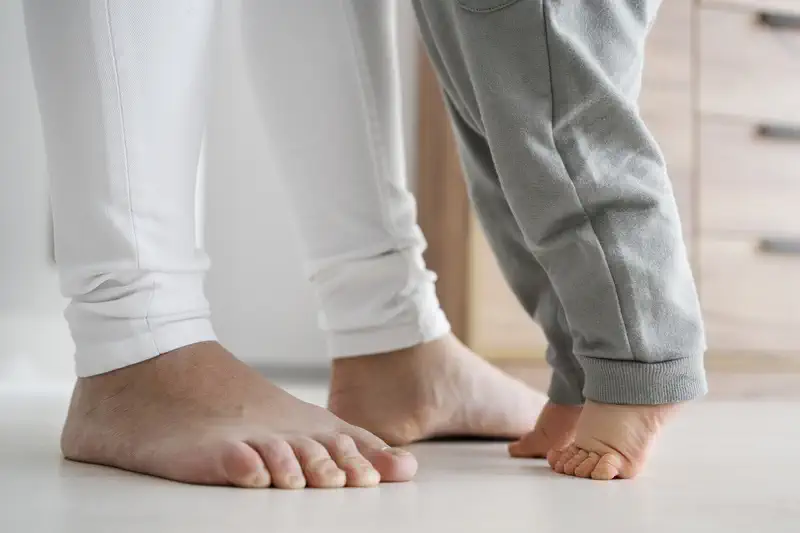Tip Toe Walking in Children Treatment Toronto
Tip Toe Walking in Children: Causes, When to Worry, and Treatment Options
Tip toe when a child walks on the balls of their feet without letting their heels touch the ground is a common sight in toddlers.
But when should parents be concerned, and what does it mean for your child’s foot health and development?

What Is Tip Toe Walking?
Tip toe walking is a gait pattern where a child consistently walks on their toes or the balls of their feet, with little or no heel contact. While it’s normal for toddlers to experiment with toe walking as they learn to walk, persistent tip toe walking beyond age 2–3 can be a sign of underlying issues.
Key characteristics:
- Absence of heel strike during the gait cycle
- Can be bilateral (both feet) or, less commonly, unilateral
- May be intermittent or constant
How Common Is Tip Toe Walking?
- Up to 24% of young children may walk on their toes at some point.
- By age 5, only about 2% of typically developing children continue to toe walk.
- Idiopathic toe walking (ITW) is diagnosed when no neurological or orthopedic cause is found and often resolves by age 10.
- Tip toe walking is more common in boys and in children with developmental delays or autism spectrum disorders.
Your Feet Deserve Professional Care
Book your appointment today and take the first step toward healthier, pain-free feet.
Causes of Toe Walking in Toddlers and Children
1. Normal Developmental Phase
- Many toddlers toe walk as they learn balance and coordination.
- Most outgrow this phase by age 2–3 without intervention.
2. Idiopathic Toe Walking in Children
- Persistent toe walking with no identifiable cause.
- May be habitual or related to sensory preferences.
3. Neurological Conditions
- Cerebral palsy: Spasticity or tightness in the Achilles tendon.
- Muscular dystrophy: Muscle weakness affecting gait.
- Autism spectrum disorder: Up to 41% of children with autism may exhibit toe walking, often linked to sensory processing differences.
4. Musculoskeletal Issues
- Achilles tendon tightness (ankle equinus): Limits ability to bring the heel down.
- Shortened calf muscles: Limits ankle flexibility.
5. Sensory Processing Toe Walking
- Some children toe walk to seek sensory input or due to heightened sensitivity to certain surfaces.
When to Worry About Toe Walking
Most toe walking in toddlers is harmless. However, seek evaluation from a pediatric podiatrist or pediatrician if:
-
- Toe walking persists beyond age 3
- Your child cannot walk flat-footed when asked
- Toe walking is unilateral (one-sided)
- There is pain, stiffness, or frequent falls
- There are developmental delays or loss of previously acquired milestones
- Family history of neurological conditions
Diagnosing Tip Toe Walking
A comprehensive assessment may include:
- Medical history: Family history, birth history, developmental milestones
- Physical exam: Gait observation, range of motion, muscle strength, and Achilles tendon flexibility
- Neurological evaluation: Reflexes, muscle tone, coordination
- Imaging: X-rays or MRI if structural or neurological conditions are suspected
Tip: Parents can keep a journal of their child’s walking patterns to help specialists with diagnosis.

What Our Customers Say
Pediatric Toe Walking Treatment Options
1. Observation and Reassurance
- For children under age 3 with no other symptoms, monitoring is usually sufficient.
2. Toe Walking Physical Therapy
- Stretching exercises: Focus on calf and Achilles tendon flexibility (e.g., wall stretches, towel stretches)
- Strengthening exercises: For foot and ankle muscles
- Balance and gait training: To promote heel-to-toe walking
3. Ankle-Foot Orthosis for Toe Walking
- Braces or splints may be prescribed for persistent idiopathic toe walking or Achilles tendon tightness.
- Worn part-time to encourage heel strike.
4. Serial Casting
- Gradually stretches the Achilles tendon over several weeks.
- Used for children with significant tightness who do not respond to therapy.
5. Sensory Integration Therapy
- For children with sensory processing issues, occupational therapy may help address underlying sensory needs.
6. Surgical Intervention
- Reserved for severe cases, especially with fixed Achilles tendon contracture or underlying neurological disorders.
Toe Walking Exercises for Kids
- Calf stretches: Stand facing a wall, place hands on the wall, and stretch one leg behind.
- Heel walking practice: Encourage walking on heels for short distances.
- Towel curls: Use toes to scrunch a towel toward the body.
- Ankle circles: Rotate ankles in both directions to improve flexibility.
Frequently Asked Questions
Is toe walking always a sign of autism?
No, but it is more common in children with autism. Most toe walking in young children is not related to autism or other neurological conditions.
Can toe walking cause problems later in life?
Persistent toe walking can lead to tight Achilles tendons, balance issues, or foot pain if untreated.
When should my child see a specialist for toe walking?
If toe walking persists beyond age 3, is one-sided, or is accompanied by other developmental concerns.
Will my child outgrow toe walking?
Most children outgrow toe walking by age 5–6, especially if it is idiopathic and not linked to other conditions.
Are special shoes or orthotics helpful?
Supportive shoes may help, but orthotics or ankle-foot orthoses are typically reserved for persistent cases.
Supporting Healthy Gait Development
- Encourage barefoot play on safe surfaces to promote natural foot development.
- Choose flexible, supportive shoes that allow normal movement.
- Monitor your child’s gait as they grow, and consult a pediatric podiatrist if concerns arise.

When to See a Pediatric Podiatrist
Contact a specialist if:
- Toe walking persists after age 3
- There are signs of muscle tightness, pain, or developmental delays
- Your child cannot bring heels to the ground when asked
Early intervention ensures the best outcomes for healthy foot and gait development.
Pregnancy Foot Care Tips
- Keep feet clean and dry: Prevent fungal infections by drying feet thoroughly after showers.
- Moisturize daily: Use safe, fragrance-free creams to prevent cracked skin.
- Trim nails straight across: Prevent ingrown toenails and related pain.
- Avoid toxic nail polishes: Choose pregnancy-safe brands free from formaldehyde, toluene, and DBP.
- Check feet regularly: Look for blisters, calluses, or changes in color, especially if you have gestational diabetes.
Edema in Pregnancy Treatment
- Hydrate: Drink water throughout the day.
- Eat potassium-rich foods: Bananas, sweet potatoes, and spinach help balance fluids.
- Limit caffeine: Excess caffeine can worsen dehydration and swelling.
- Swim or stand in a pool: Water pressure reduces swelling and soothes tired feet.

Tip toe walking is often a normal part of early childhood development, but persistent or one-sided toe walking can signal underlying issues. With early evaluation and the right interventions-from physical therapy to orthotics-most children achieve a healthy, pain-free gait.
Looking for better foot support? We're just around the corner.
Call us today at
